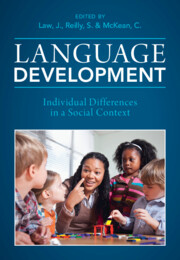Book contents
- Language Development
- Language Development
- Copyright page
- Contents
- Figures
- Tables
- Contributors
- A Tribute to Our Friend, Colleague and Fellow Editor, Professor James Law
- Introduction
- Part One Factors Influencing Language Development
- Part Two Continuity and Change
- 11 Language Trajectories in Childhood
- 12 Patterns of Language Development from Childhood to Adulthood and the Associated Long-term Psychosocial Outcomes
- 13 Social Inequalities in Vocabulary and the Role of Reading
- 14 The Dynamic Nature of Predictors and Outcomes in Children’s Language Development over Childhood
- Part Three Impact, Intervention and Equity
- Index
- References
14 - The Dynamic Nature of Predictors and Outcomes in Children’s Language Development over Childhood
from Part Two - Continuity and Change
Published online by Cambridge University Press: 11 August 2022
- Language Development
- Language Development
- Copyright page
- Contents
- Figures
- Tables
- Contributors
- A Tribute to Our Friend, Colleague and Fellow Editor, Professor James Law
- Introduction
- Part One Factors Influencing Language Development
- Part Two Continuity and Change
- 11 Language Trajectories in Childhood
- 12 Patterns of Language Development from Childhood to Adulthood and the Associated Long-term Psychosocial Outcomes
- 13 Social Inequalities in Vocabulary and the Role of Reading
- 14 The Dynamic Nature of Predictors and Outcomes in Children’s Language Development over Childhood
- Part Three Impact, Intervention and Equity
- Index
- References
Summary
This chapter examines factors that influence early language capabilities and the dynamic nature of children’s language development across childhood. Language skills can facilitate literacy and early success at school, as well as contributing to adaptive functioning through the development of communication and social-emotional skills. The early home learning environment is an important predictor of language development and school readiness in preschool and kindergarten children. We focus on two studies that use Australian data to investigate environmental predictors of early language skills and how, across childhood, variations in language skills and peer problems impact on mental health in early adolescence. In Study 1, the associations between specific aspects of the early home learning environment and children’s language development in the first three years are investigated, drawing on data from a large sample of socio-economically vulnerable families living in Australia. Study 2 investigates the cross-lagged associations between child receptive vocabulary and peer problems over middle childhood (4–5, 6–7 and 8–9 years) and subsequent mental health problems in early adolescence (12–13 years).
Keywords
- Type
- Chapter
- Information
- Language DevelopmentIndividual Differences in a Social Context, pp. 322 - 346Publisher: Cambridge University PressPrint publication year: 2022



